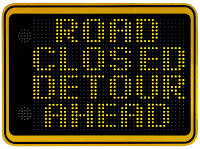NHTSA released an
early estimate of traffic fatalities for the first
quarter of 2012, with frightening results. An estimated 7,630 people died in
car crashes during these three months, an increase of 13.5% compared to the
first quarter of 2011. The miles traveled increased as well, but only by 1.4%,
certainly not accounting for the 13.5% increase in fatalities.
If these projections are realized, this will indicate
the second largest
increase in fatalities since NHTSA first started recording traffic fatalities
in 1975. The largest increase in fatalities was in the first quarter of 1979
with a 15.3% in the number of traffic related deaths.
The 2012 increase in fatalities is following a historic downtrend in traffic
fatalities over the past few years.
Were the increased fatalities due to texting while driving? Long
stretches of road inviting drivers to speed? Younger, less experienced drivers?
Tired driving?
Whatever the cause of the increase in fatalities, creating safer roads is
critical to prevent fatalities going forward.
Traffic calming is key in
preventing accidents. Study after study on
speed humps,
radar speed signs, and
other traffic calming solutions all lead to the same conclusion: traffic
calming reduces accidents, and when they do happen, reduces the severity of the
outcome.
Solutions such as speed humps that compel drivers to slow down, or
speed display signs that return driver focus to the road, are integral to protecting drivers,
passengers, and pedestrians.
Safer roads = Better driving = Less accidents = Fewer deaths
Together we can save lives.
 Everybody plans on staying safe during the holiday season. But each year, too many people are hurt and killed during the holidays due to traffic accidents. Why are people more at risk during the holiday season? What can you do to avoid accidents and ensure that you protect yourself and your family? What can you do to ensure that the streets of your city are safer for everyone?
Everybody plans on staying safe during the holiday season. But each year, too many people are hurt and killed during the holidays due to traffic accidents. Why are people more at risk during the holiday season? What can you do to avoid accidents and ensure that you protect yourself and your family? What can you do to ensure that the streets of your city are safer for everyone?




































